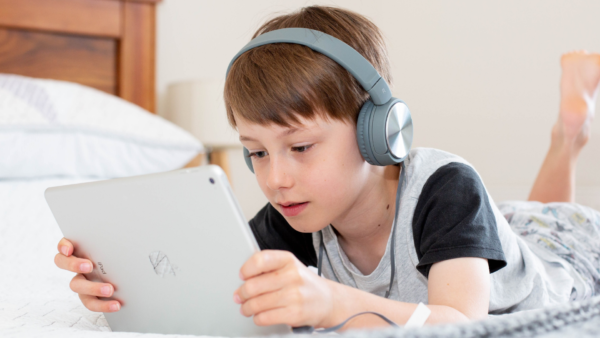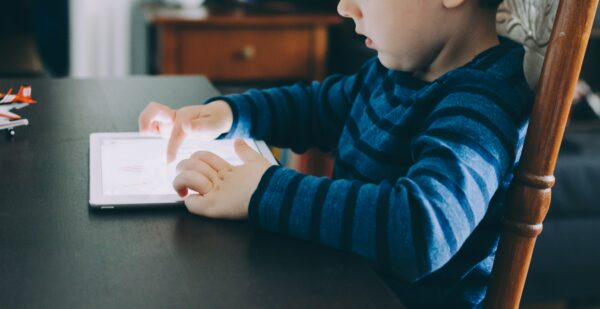Screen-time tips for your primary-school aged son
Screen time. Aside from the pandemic, it’s one of the most discussed topics among parents of primary-aged kids.

For some children, especially those dealing with months of lockdowns and COVID restrictions, screens have become their lifelines. They’ve allowed kids to learn, work, create, communicate and stay socially connected.
The flipside is that overuse and misuse of screens can take its toll on kids’ mental, physical and emotional health and wellbeing, creating issues with everything from face-to-face socialising and focus to falling asleep.
The key to screen use is balance. However, expecting your primary-aged son to self manage his device use might be a bit of a stretch…
Here are some tips to help you step in and ensure your son doesn’t turn into a screen-obsessed zombie.
Establish screen-based rules
I’m pretty sure that without boundaries, my sons would stay on screens until their eyes bled. And I’m not sure even that would deter them.
I used to yell at them about how we used to play outside when I was young and how they should be reading a book… but unsurprisingly, this tactic left us all feeling stressed and disconnected.
So rather than continue this screening/screaming cycle, we sat down as a family and created ‘the rules’, which have (mostly) saved both arguments and sanity.
The rules include:
- What screens can be used for (e.g. Minecraft but no unsupervised YouTube surfing).
- When they can be on their devices (e.g. no screen time until chores and homework are done, and no screens after 7pm).
- Where they can use screens (e.g. yes to shared spaces such as the living room; no to screens in the bedroom).
- How long they can be on screens (e.g. 1 hour on school days, 2 on weekend days or school holidays).
Keep screen sessions short
Longer screen sessions mean longer periods of sitting down – not great for your son’s posture or physical wellbeing. Encourage your son to stick to shorter screen sessions or take regular breaks every 30 minutes or so.
Make break-time activities physical and fun, such as bouncing on the trampoline, shooting a few hoops or dancing to your son’s favourite song.
Set a transitioning off screens routine
- Set expectations before the session starts. For instance, he can watch one TV show or play until it’s time to set the table for dinner.
- Give a 5-minute warning. When time’s almost up, get your son’s full attention and tell him he has 5 minutes left.
- Clearly state what needs to be done when time is up (the iPad needs to go away now) and the consequence if it doesn’t (you’ll lose 10 minutes of screen time tomorrow).
- Praise and reward him for responsible use of screen time, to help ensure the good behaviour sticks.
If your son is still having issues sticking to the rules, try a WiFi timer, consider installing programs or filters that can block access to inappropriate sites or content, and avoid addictive games that prompt ‘one more try’.

Get your screen-time timing right
Once your son is on a screen, it’s going to be hard to get him off it, so encourage him to have breakfast, get dressed and take a walk/do his chores before he can plug into his device.
And don’t forget that primary-school aged children need around 9 to 11 hours’ sleep a night. Avoid devices in the hour before bed (screens can affect how quickly your son falls asleep) and keep screens out of the bedroom.
Be your kid’s screen-time role model
How you use screens will have a major impact on your son’s screen use. Model good device use by muting notifications and putting limits on your own screen time – and sticking to them. Figure out some screen alternatives you can do together, such as playing board games or exercising.
Setting boundaries around screen time can be hard, especially at the moment with many parents juggling 4,000 other things. But creating positive relationships with screens now will help your son become responsible user in future. And all that screen-free quality time may even help you build a stronger, more connected relationship with your son.
Want to learn more about kids and screen use? Check out the Crowther Centre’s online resource here.
Brought to you by Brighton Grammar School
Bec Cavalôt is a Melbourne-based writer, and mum of two beautiful, boisterous boys. You can find her at www.cavalotcopy.com. This article is about ParentingYOU MAY ALSO ENJOY
Subscribe to Understanding Boys. It’s free!
Got boys? Sign up for tips and advice you'll actually use.



